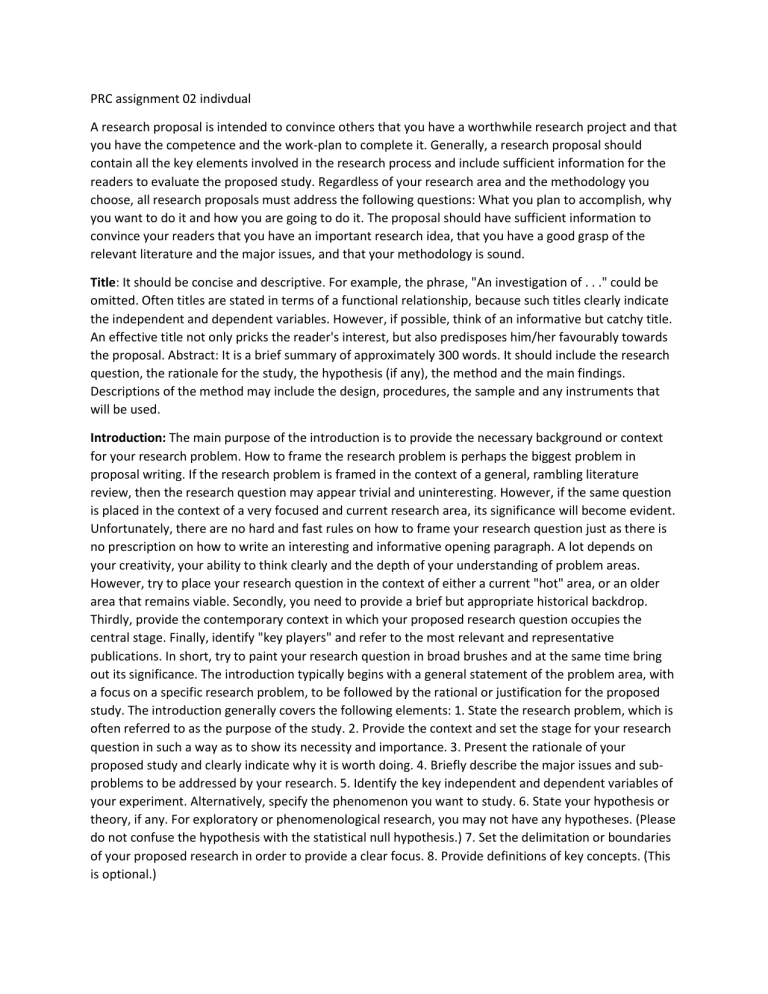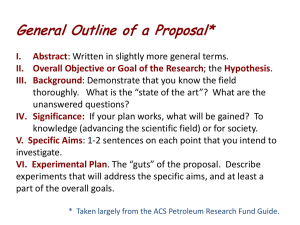
PRC assignment 02 indivdual A research proposal is intended to convince others that you have a worthwhile research project and that you have the competence and the work-plan to complete it. Generally, a research proposal should contain all the key elements involved in the research process and include sufficient information for the readers to evaluate the proposed study. Regardless of your research area and the methodology you choose, all research proposals must address the following questions: What you plan to accomplish, why you want to do it and how you are going to do it. The proposal should have sufficient information to convince your readers that you have an important research idea, that you have a good grasp of the relevant literature and the major issues, and that your methodology is sound. Title: It should be concise and descriptive. For example, the phrase, "An investigation of . . ." could be omitted. Often titles are stated in terms of a functional relationship, because such titles clearly indicate the independent and dependent variables. However, if possible, think of an informative but catchy title. An effective title not only pricks the reader's interest, but also predisposes him/her favourably towards the proposal. Abstract: It is a brief summary of approximately 300 words. It should include the research question, the rationale for the study, the hypothesis (if any), the method and the main findings. Descriptions of the method may include the design, procedures, the sample and any instruments that will be used. Introduction: The main purpose of the introduction is to provide the necessary background or context for your research problem. How to frame the research problem is perhaps the biggest problem in proposal writing. If the research problem is framed in the context of a general, rambling literature review, then the research question may appear trivial and uninteresting. However, if the same question is placed in the context of a very focused and current research area, its significance will become evident. Unfortunately, there are no hard and fast rules on how to frame your research question just as there is no prescription on how to write an interesting and informative opening paragraph. A lot depends on your creativity, your ability to think clearly and the depth of your understanding of problem areas. However, try to place your research question in the context of either a current "hot" area, or an older area that remains viable. Secondly, you need to provide a brief but appropriate historical backdrop. Thirdly, provide the contemporary context in which your proposed research question occupies the central stage. Finally, identify "key players" and refer to the most relevant and representative publications. In short, try to paint your research question in broad brushes and at the same time bring out its significance. The introduction typically begins with a general statement of the problem area, with a focus on a specific research problem, to be followed by the rational or justification for the proposed study. The introduction generally covers the following elements: 1. State the research problem, which is often referred to as the purpose of the study. 2. Provide the context and set the stage for your research question in such a way as to show its necessity and importance. 3. Present the rationale of your proposed study and clearly indicate why it is worth doing. 4. Briefly describe the major issues and subproblems to be addressed by your research. 5. Identify the key independent and dependent variables of your experiment. Alternatively, specify the phenomenon you want to study. 6. State your hypothesis or theory, if any. For exploratory or phenomenological research, you may not have any hypotheses. (Please do not confuse the hypothesis with the statistical null hypothesis.) 7. Set the delimitation or boundaries of your proposed research in order to provide a clear focus. 8. Provide definitions of key concepts. (This is optional.) Literature Review: Sometimes the literature review is incorporated into the introduction section. However, most professors prefer a separate section, which allows a more thorough review of the literature. The literature review serves several important functions: 1. Ensures that you are not "reinventing the wheel". 2. Gives credits to those who have laid the groundwork for your research. 3. Demonstrates your knowledge of the research problem. 4. Demonstrates your understanding of the theoretical and research issues related to your research question. 5. Shows your ability to critically evaluate relevant literature information. 6. Indicates your ability to integrate and synthesize the existing literature. 7. Provides new theoretical insights or develops a new model as the conceptual framework for your research. 8. Convinces your reader that your proposed research will make a significant and substantial contribution to the literature (i.e., resolving an important theoretical issue or filling a major gap in the literature). Title It sounds somewhat obvious when we say that your research proposal with a title. To say the least, you already know you should. But perhaps the most common mistake that many students make is to write general titles that lack focus. Instead of writing a long title that’s hard to read or a short title that fails to highlight the theme of your research, write a clear and concise headline that tells your reader what your research proposal is about at a first glance. 2. Introduction The starting paragraph to a research project is one of the elements of a good research proposal because it introduces the subject you wish to address or a research problem you wish to analyze. Because the introduction of a research proposal is what sets the tone for the rest of the paper, it’s important to start with a hook and then organize your thoughts in a logical and organized manner. The introduction to your research proposal should give background information and explain why you believe a research question is worth exploring. While not mandatory, you can briefly describe your methodologies in the introduction and then expand them later on. Your introduction should be clear and concise. Make sure you include only the most relevant information in this section so you don’t make it unnecessarily too long. 3. Literature Review Although a research proposal doesn’t include a full literature review, it’s important to include an overview of the most significant studies in your field. The section should feature evidence and statistical data to demonstrate the significance of your research. Through the literature review, you can easily draw your reader’s attention to existing research, identify gaps in existing studies, and make your reader understand how your proposal will contribute to the already existing research. 4. Aims and Objectives Aims and objectives are what you wish your research proposal to accomplish. Your aims will be your overall outcome or what you want the research to achieve. Objectives tend to be narrower and more focused. More often than not, you need to provide an explanation for each of your objectives to show how they will help to meet the aims of your study. Unless required, you don’t really have to include a hypothesis that your research proposal looks forward to test. 5. Research Methodology Methodologies are simply the research methods you will use to conduct your study and they must appear in your research proposal whether or not you’re conducting an experimental research. The methodologies include analysis and sampling techniques equipment, research approaches, and ethical concerns. Make sure your explanation for each methodology is clear and precise. It helps to justify why you’ve chosen to use a certain methodology over an alternative. This will go a long way to show that you took your time to think about your methodologies before picking them. It’s important to explain how you will collect data, the sample size you plan to consider for your research investigation, and the techniques you consider the most appropriate to analyze the data. 6. Scope of the Research Because you’ll be working with limited time and resource, it’s reasonable to include a section on the scope of the research in your proposal. In other words, you have to show your reader that you can start and complete your research within the constraints of these two resources. Remember, your research will more than likely have limits, and addressing them in this section not only shows that you have given them a thought but also makes your research proposal strong and authentic. Don’t just focus on the challenges that you’re likely to come across during your studies. You should also propose alternative solutions that you can use and why they might help. 7. Outline and Timetable Your professor expects to see an outline and a timetable in your research proposal so it’s important that you include them in your research proposal. The purpose of the outline is to show how you plan to structure your dissertation. Briefly note what each section will cover and explain how it all fits into the argument of your research project. The purpose of the timetable is to show how much time you’ll need to complete your research. In particular, you need to make sure you mention exactly how long you expect each stage of your study to take. Don’t just mention how long the research process will take. Make sure you also indicate how long you’ll take to compile your research.


